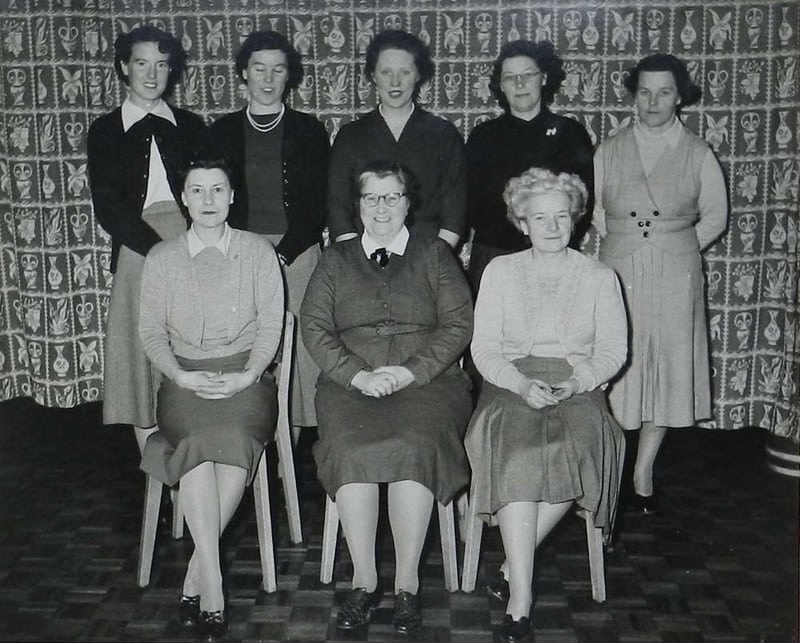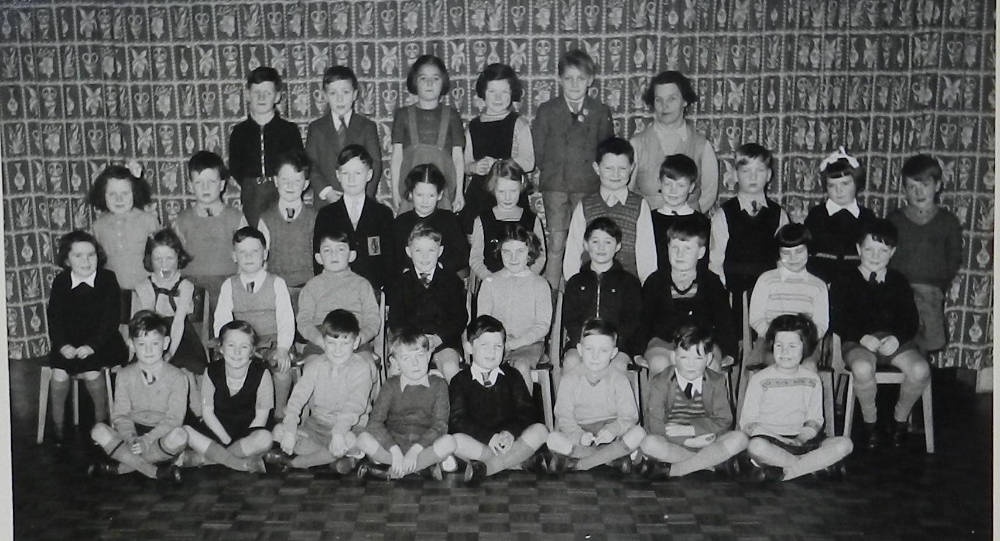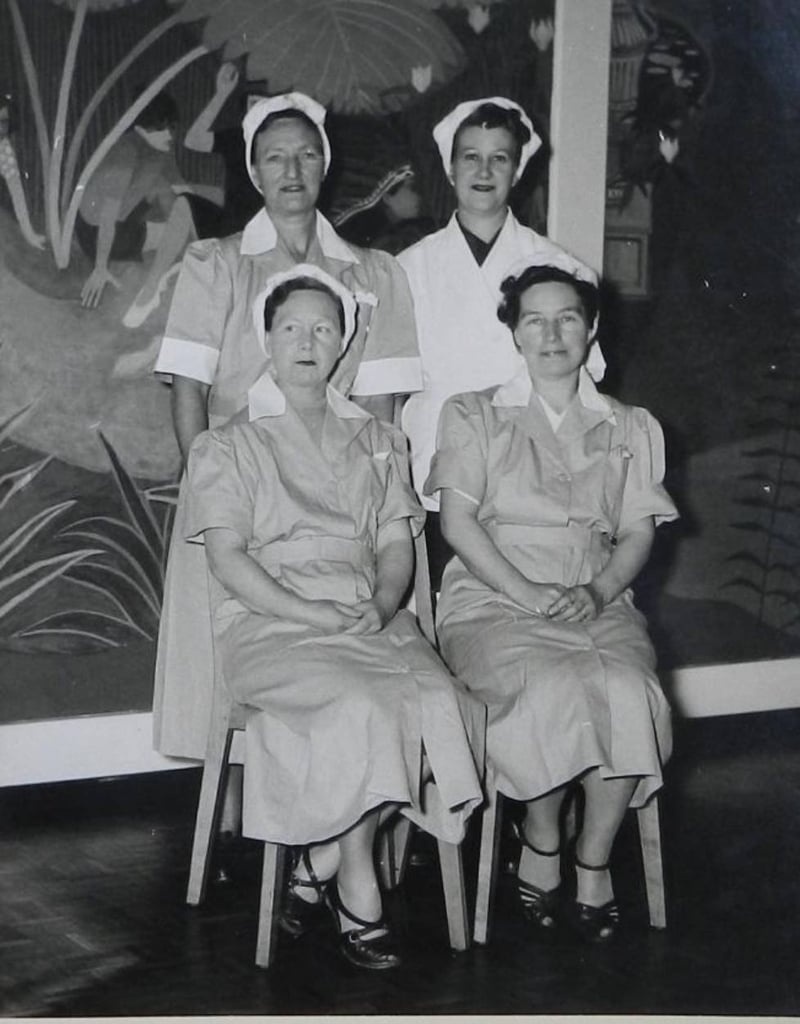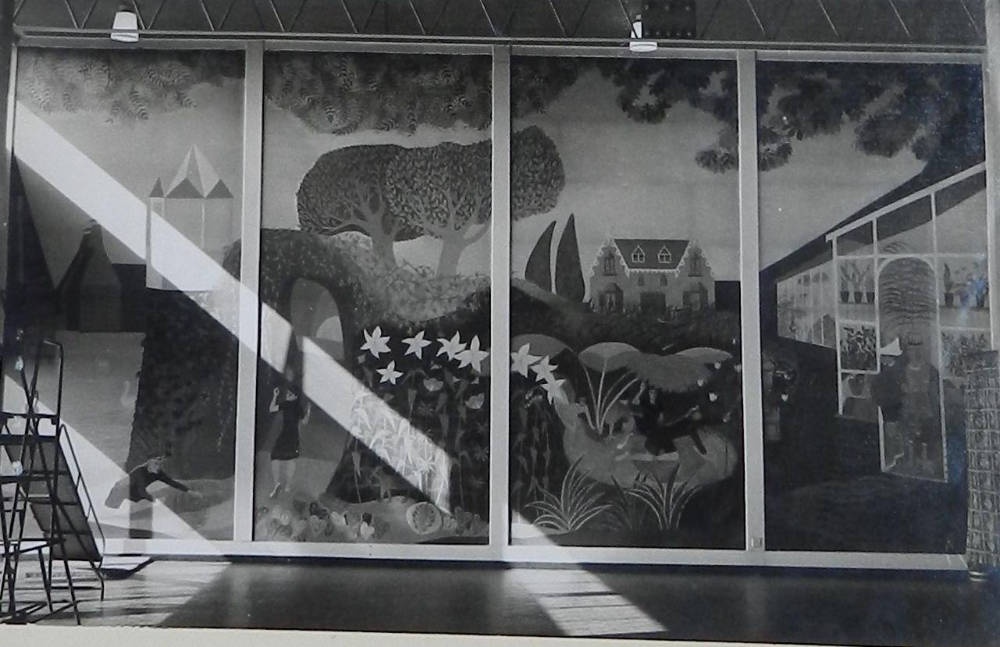School History
Windsor Drive History
Our school, Danegrove School, is on two sites. The Windsor Drive part of the school, then called Littlegrove Mixed School, was opened in August 1933 with 396 children. Two years later there were 700 children on the roll (although there was only supposed to be space for 576) arranged in 13 classes with an average of 54 children in each class. An old school Log Book recently came to light (pictured right) which contains much interesting information about the school. Log Books were kept by the Headmaster and were updated by him on a regular basis about events connected to school life. Much of the information below comes from this book.

There were 6 classrooms on the ground floor and a hall – as the main school building is today. Imagine trying to squeeze over 50 children in to one of our classrooms? We feel quite squashed with only 30 today, especially in Year 6! Upstairs there were another 6 classrooms and another hall, with a stage in it. (This hall is now the library and the computer room. Nowadays we cannot imagine the school without the library but a reference and lending library was first discussed only on 27 October 1942.) Both halls were used as classrooms and four more classrooms were built in two temporary huts to accommodate all the children (I think these are the black huts which currently contain Year 2 and our Learning Mentor). The playground was divided in half with one area for boys and the other for girls. Boys would go into the main school at one end of the building and girls at the other, rather than in year groups as we do now.
As today, there were children aged from 4 years old but there were also children aged over 11. Two hundred and eighteen of these older children left in March 1939 because new senior schools had been built at Russell Lane and Victoria Road. (Neither of these schools exists now. Russell Lane became Southaw School but more recently has been demolished and housing built in its place. A remnant of the Victoria Road school exists as a Community Centre but the rest of the buildings suffered the same fate as Russell Lane and also became housing.)
Pupils
In May 1938 we learn that Vera Pickerden, Eileen Geraghty, Owen Robinson and Thomas Bullen had been awarded special places at East Barnet Modern School (later East Barnet County, then East Barnet Grammar, now East Barnet School) whilst Constance Aldridge and Maureen Fuller gained the same at Queen Elizabeth’s Grammar School (now Queen Elizabeth Girls’ School and, separately, Queen Elizabeth Grammar which is a boys’ school). Other local grammar schools at which the children gained places include the Junior Technical School at Watford, Cheshunt Grammar, St Michael’s RC at Finchley, Finchley Grammar, Minchenden Grammar at Southgate, Hatfield Technical School, Borehamwood Grammar, Haberdasher’s School, St Alban’s School and one girl, Barbara Baker even managed to gain a place at Sadlers Wells Ballet School.
Other occasions when children are mentioned by name are when they were accidentally hurt. The first of these reports occurred on 28 April 1938 when, during an organised games period, Arthur Smith fell and injured his knee seriously. He was taken immediately to Dr Guggenheim who instructed the Headmaster to take the boy to the Wellhouse Hospital (Barnet General) where he had a minor operation. Children, then as now, occasionally did things which they should not have done: on 13 April 1948 it is recorded that a child lost his balance while climbing on the railings, which was forbidden, and broke 2 front teeth. This is why children are still not allowed to climb on the railings!
Staff
By 1937 there were 441 children attending the school and 12 teachers. The Headmaster was Mr Norris J Daft and the other teachers were: Mr R A Muncey, chief assistant master, Mr W H Elliott, Mr A W Harris, Mr A Marsh and Mr G Nichols all ‘Trained Certificated Assistant Masters’, Misses E Smith, J Monk, B Frost, D Crackle, all ‘Trained Certificated Assistant Mistresses’, Miss J Spink, Uncertificated Assistant and Miss B Thomas, Trained Uncertificated Mistress. Nowadays we have double the number of teachers and lots of support staff too.
As today, sometimes a supply teacher was needed if one of the regular teachers was unwell. Around 1940 this was often a Mr Johnson, who stood in for teachers with German measles and a broken ankle, amongst other illnesses.
Sometimes teachers sent a telegram to the Headmaster, telling him that they were not well and unable to come to school that day. These were the days before computers and mobile phones. Indeed, most houses did not have any sort of telephone at all. It was actually quicker to send a telegram – some 65 million telegrams were sent each year at this time. You had to take your message to your local Telegraph Office where it would be sent electronically to the Office nearest to the destination. There it was printed out and delivered immediately, usually by a young man on a motorbike or bicycle.
The School Day
Subjects mentioned in the HMI (the OFSTED of their day) report of 1938 include English, Arithmetic, Geography, History, Arts and Crafts, Needlework – all satisfactory but the training of older girls in Domestic Subjects was considered ‘very inadequate’. The 1955 Report also includes Religious Education, Information Subjects [what were these?] and Music – both recorder and violin lesson were given.
Sports days were held at Oakhill Park and there various cups and shields waiting to be won. The Littlegrove children were arranged into four houses: Lancaster, Richmond, Gloucester and York, which competed against each other on these occasions. (The houses also competed for the Lawson Shield, awarded for good academic work throughout the year.) On 9 June 1939 Littlegrove won the netball shield in the Inter School Sports tournament, the equivalent of going to Copthall today.
All children went home for lunch and the school was shut for two hours from noon until 2pm. However on 1 July 1941 there was a meeting to discuss the opening of a ‘School Dinner Club’ and to make arrangements for a kitchen. It was suggested that the Infants’ cloakroom at the Boys’ end of the school could be used. Kitchen staff were appointed on 4 November: Cook, Mrs G W Albury; Assistant Cooks, Mrs J Arnold and Mrs E Watts; Kitchen Helps Mrs N Bearsdon, Mrs S Smith and Mrs Walsh. The canteen opened on 19 November and 376 dinners were served that day.
The Log Book contains other information about school life, for instance the children went on various educational trips. The earliest mentioned is a display of films about India and Ceylon which took place at the Odeon Cinema on 25 October 1937 for the children aged over 11. Unsurprisingly, there appear to have been no trips during the war, the next one being on 17 December 1946 when a party of 50 children visited the Britain Can Make It exhibition. Later visits included A1 Dairies at Whetstone, Whipsnade and London Zoos, the Science Museum, Westminster Abbey, the Tower of London and St Albans’ Roman Museum.
Policemen from the Metropolitan Police gave regular talks to the children on Safety First. We still have visits by the police on subjects such as Stranger Danger in order to help us stay safe.
Weather Problems
We have had some very snowy weather in recent years but the school is always open for business. Severe winter weather in February 1940 meant that less than half of the children were able to come to school. By 13 March the supply of coal, used for heating the school building, had been exhausted and the school had to shut as no more could be obtained until 15 March.
The coal again ran out on 10 December, resulting in the school being closed for the day, but by 20 December this, too, had run out. The heating apparatus as damaged by frost during the Christmas holidays, meaning that the school could not re-open on 7 January as it was supposed to but had to delay the start of term until 13 January.
January 1942 was also very cold and the temperature in the huts was below freezing for eight days on the trot, making work in them impossible. The County Surveyor’s Department’s solution was to provide black-out shields so that the fire (used instead of radiators) could be kept burning throughout the night. The chimneys in the huts were swept too, in an attempt to get better heating.
Another bad winter was that of 1947. On Thursday 30 January it was reported that all of the outside lavatory pans and cisterns had frozen solid making them unusable – all of the children were sent home until the following Monday.
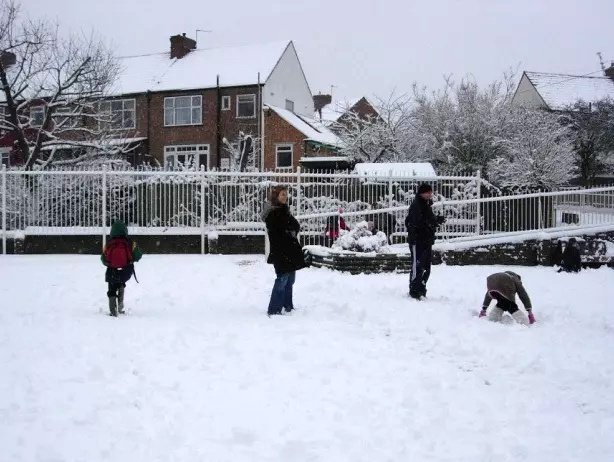
The War
Of course the War also caused the pupils to miss some of their schooling and it also changed their school lives forever. Although 1 September 1939 is now considered to be the start of the War, it was well before this, on 25 April 1939, that the Air Raid Precaution Officer for Hertfordshire called on the school to inspect the grounds and to discuss with the Headmaster the site for 180 yards of trenches. The school was inspected by HMI on 30 September; not only the children’s work but also the school trenches! By 8 November they were unfit for use due to flooding and the children had to be accommodated in the safer parts of the building, as far as possible away from glass - four classes on the upper floor, two on the ground floor and four in the basement.
On 21 May 1940, two teachers imparted to the rest of the staff knowledge they had gained at special courses on dealing with incendiary (fire) bombs. By 28 May, a stirrup pump and pail, incendiary bomb scoop and sand bin were placed in a convenient location in the Lower Hall.
The school air raid shelter was first mentioned on 4 September 1939. School should have opened after the summer vacation on this day but all of the staff had to attend the Clerk’s Office to receive instructions concerning arrangements for opening the school when the shelters were completed. Work on the shelter was inspected in November and December and three of the four shelters had been completed by 28 May 1940. The first air-raid warning on 16 August meant that 45 minutes was spent in the shelters but on some days, such as 13 September, the children were in the shelters for over 4 hours.
Mr G Rebitt of the County Surveyor’s Department inspected the school shelters on 10 June 1941 where the headmaster pointed out to him that owing to recent rains they were unfit for use. By 17 July it was agreed that the trenches, too, would never keep out water after a few days of heavy rain and that the main school building should be used instead of the air raid shelter in bad weather. The Headmaster suggested that certain windows should be covered with wire to protect them and this was agreed, as was the suggestion that screen should be placed in front of the shelter lavatories.
New shelter arrangements were completed on 21 January 1943 as the others were damp and unfit for use. Instead, the children were to use the surface shelters; 2 in Ridgeway Avenue, 4 in Windsor Drive and 4 in Eton Avenue. The children were able to reach these shelters in 3½ minutes! On 13 November 1946, after the war had ended, Rona [?] Jenkins, aged 9, fell down one of the air-raid shelters, dislocating her elbow and fracturing her wrist. This was the last mention of the shelters in the Log Book.
Education was much disrupted during the War. On 2 September 1940 only 304 children were present out of 428 on the roll. An air raid warning on 13 September lasted from 9.50am until 2pm – the children were then sent home. Warnings on 17 September lasted from 8.10am until 8.50am and then from 9.10am until 10am. Only 115 children were present and so it was decided to close the school for the day. The school day was split into two halves and if an air raid warning took place which lasted over the start of the afternoon session, this was often cancelled. The County Council instructed that one member of staff must remain on duty to turn away any children returning for the afternoon session. On 9 October this was Mr G Nichols, although the acting Headmaster kept him company until 3pm.
On 10 February new times for the school day came into operation: 9.30am to 12 noon for the morning session and 2pm until 4.30pm for the afternoon. By 3 March this was changed to 9am to noon and 2-4pm. The summer holiday that year only lasted from 26 July until 12 August 1940, although a further week’s holiday was granted by the County Council on 23 August. Two years later, on 2 October 1942, the Log Book states that the school was closed for the residue of the Summer Holiday! Was this something that only happened in the War?
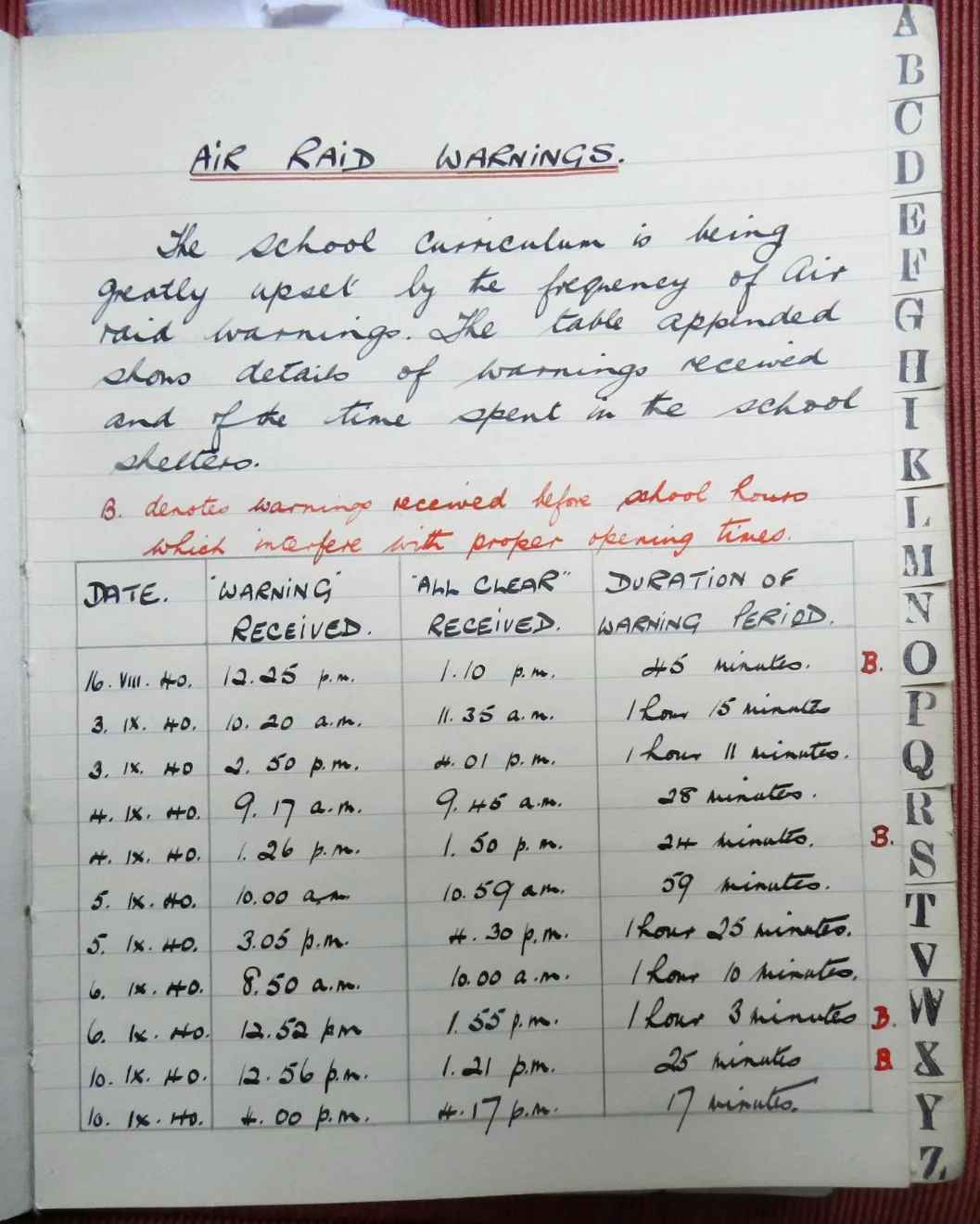 At 10.15pm on 20 February 1944 three bombs fell in the neighbourhood of the school. One fell in the corner of the school field where the pond is now, a second in a back garden adjacent to the north end of the playground (near the domes) and a third in the middle of the carriageway on Cat Hill. The school was damaged and had to be closed for a week for repairs – about 600 roof tiles were broken along with 160 panes of glass. Each of the wooden huts had one side bulging and the roof of one hut was broken in several places; two of the heating stoves were damaged. The boundary wall on the north side of the playground and the tarmac there were badly damaged and many tons of clay had been thrown onto the playground. In the surrounding area some 1500 people were without gas and water supplies and so the school canteen was opened as an Emergency Feeding Service, providing some 60 breakfasts, 470 dinners and 60 teas. By later that afternoon the gas and water supplies were reconnected.
At 10.15pm on 20 February 1944 three bombs fell in the neighbourhood of the school. One fell in the corner of the school field where the pond is now, a second in a back garden adjacent to the north end of the playground (near the domes) and a third in the middle of the carriageway on Cat Hill. The school was damaged and had to be closed for a week for repairs – about 600 roof tiles were broken along with 160 panes of glass. Each of the wooden huts had one side bulging and the roof of one hut was broken in several places; two of the heating stoves were damaged. The boundary wall on the north side of the playground and the tarmac there were badly damaged and many tons of clay had been thrown onto the playground. In the surrounding area some 1500 people were without gas and water supplies and so the school canteen was opened as an Emergency Feeding Service, providing some 60 breakfasts, 470 dinners and 60 teas. By later that afternoon the gas and water supplies were reconnected.
Other Log Book entries concerning the war mention that the huts were commandeered by the officer commanding No 3 Squadron (Middlesex Yeomanry) Division Signals on 25 October 1939, the Headmaster attended a meeting on 13 February 1941 to discuss the education of evacuee children in East Barnet and the County Rural Organisers visited the school on 21 October 1942 to discuss the question of ploughing up the field. Nothing further is reported of these events.
Ridgeway Avenue History
The Ridgeway Avenue part of our school, housing Reception and Year 1, was formerly Oaklands Infant School. This building was designed by the famous Architects Co-Partnership in 1950, making use of a modified form of a steel frame with precast concrete panels and coloured infill which was the most modern design at that time. What was different from the way schools were previously built was the way that the corridors zig-zag, making a more informal learning space. The building is listed with The National Heritage as being of special architectural or historic interest. There is a picture of the school on the website of the Royal Institute of British Architects looking much the same as it does today.
The building is listed with The National Heritage as being of special architectural or historic interest. There is a picture of the school on the website of the Royal Institute of British Architects. Despite being taken in 1951, the school looks much the same as it does today.

After the war, art works were often commissioned for new schools to develop children’s visual experiences and the tall hall at Oaklands had a mural, a rural scene, especially designed and painted by Fred Millett in 1951. It is still there, although now covered over. Fred Millett went on to design posters for London Transport.

We have an old book from Oakland InfantSchool too, pictured above. This is a photograph album and one page is dated 1954. These are the photos– do you recognise anyone? Do let us know if you do! Or of any memories if you used togo to this school.





